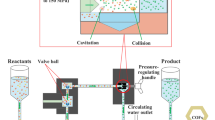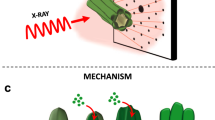Abstract
A variety of host compounds have been used as molecular-scale reaction vessels, protecting guests from their environment or restricting the space available around them, thus favouring particular reactions. Such molecular 'flasks' can endow guest molecules with reactivities that differ from those in bulk solvents. Here, we extend this concept to crystalline molecular flasks, solid-state crystalline networks with pores within which pseudo-solution-state reactions can take place. As the guest molecules can spontaneously align along the walls and channels of the hosts, structural changes in the substrates can be directly observed by in situ X-ray crystallography during reaction. Recently, this has enabled observation of the molecular structures of transient intermediates and other labile species, in the form of sequential structural snapshots of the chemical transformation. Here, we describe the principles, development and applications of crystalline molecular flasks.
This is a preview of subscription content, access via your institution
Access options
Subscribe to this journal
Receive 12 print issues and online access
$259.00 per year
only $21.58 per issue
Buy this article
- Purchase on Springer Link
- Instant access to full article PDF
Prices may be subject to local taxes which are calculated during checkout








Similar content being viewed by others
References
Yoshizawa, M., Klosterman, J. K. & Fujita, M. Functional molecular flasks: New properties and reactions within discrete, self-assembled hosts. Angew. Chem. Int. Ed. 48, 3418–3438 (2009).
Cram, D. J., Tanner, M. E. & Thomas, R. The taming of cyclobutadiene. Angew. Chem. Int. Ed. Engl. 30, 1024–1027 (1991).
Ramamurthy, V. & Venkatesan, K. Photochemical reactions of organic crystals. Chem. Rev. 87, 433–481 (1987).
Lauher, J. W., Fowler, F. W. & Goroff, N. S. Single-crystal-to-single-crystal topochemical polymerizations by design. Acc. Chem. Res. 41, 1215–1229 (2008).
Ohashi, Y. in Models, Mysteries and Magic of Molecules (eds Boeyens, J. C. A. & Ogilvie, J. F.) 109–113 (Springer, 2008).
Coppens, P., Vorontsov, I. I., Graber, T., Gembicky, M. & Kovalevsky, A. Y. The structure of short-lived excited states of molecular complexes by time-resolved X-ray diffraction. Acta Cryst. A61, 162–172 (2005).
Moffat, K. Time-resolved biochemical crystallography: A mechanistic perspective. Chem. Rev. 101, 1569–1581 (2001).
Kohlschutter, V. & Tuscher, J. L. Zur Kenntnis topochemischer Reaktionen. Über Bildung und Verhalten von Kupferhydroxyd. Z. Anorg. Allg. Chem. 111, 193–236 (1920).
Caulder, D. L. & Raymond, K. N. Supermolecules by design. Acc. Chem. Res. 32, 975–982 (1999).
Fujita, M. Metal-directed self-assembly of two- and three-dimensional synthetic receptors. Chem. Soc. Rev. 27, 417–425 (1998).
Conn, M. M. & Rebek, J. Jr Self-assembling capsules. Chem. Rev. 97, 1647–1668 (1997).
Hof, F., Craig, S. L., Nuckolls, C. & Rebek, J. Jr Molecular encapsulation. Angew. Chem. Int. Ed. 41, 1488–1508 (2002).
Fujita, M., Tominaga, M., Hori, A. & Therrien, B. Coordination assemblies from a Pd(II)-cornered square complex. Acc. Chem. Res. 38, 369–378 (2005).
Kang, J. M. & Rebek, J. Jr Acceleration of a Diels–Alder reaction by a self-assembled molecular capsule. Nature 385, 50–52 (1997).
Pluth, M. D., Bergman, R. G. & Raymond, K. N. Acid catalysis in basic solution: A supramolecular host promotes orthoformate hydrolysis. Science 316, 85–88 (2007).
Yoshizawa, M., Tamura, M. & Fujita, M. Diels–Alder in aqueous molecular hosts: Unusual regioselectivity and efficient catalysis. Science 312, 251–254 (2006).
Batten, S. R. & Robson, R. Interpenetrating nets: Ordered, periodic entanglement. Angew. Chem. Int. Ed. 37, 1460–1494 (1998).
Eddaoudi, M. et al. Modular chemistry: Secondary building units as a basis for the design of highly porous and robust metal–organic carboxylate frameworks. Acc. Chem. Res 34, 319–330 (2001).
Kitagawa, S., Kitaura, R. & Noro, S. Functional porous coordination polymers. Angew. Chem. Int. Ed. 43, 2334–2375 (2004).
Moulton, B. & Zaworotko, M. J. From molecules to crystal engineering: Supramolecular isomerism and polymorphism in network solids. Chem. Rev. 101, 1629–1658 (2001).
Yaghi, O. M. et al. Reticular synthesis and the design of new materials. Nature 423, 705–714 (2003).
Férey, G. Hybrid porous solids: Past, present, future. Chem. Soc. Rev. 37, 191–214 (2008).
Fujita, M. et al. Self-assembly of 10 molecules into nanometre-sized organic host frameworks. Nature 378, 469–471 (1995).
Cohen, M. D. & Schmidt, G. M. J. Topochemistry. 1. Survey. J. Chem. Soc. 1996–2000 (1964).
Yoshizawa, M., Takeyama, Y., Kusukawa, T. & Fujita, M. Cavity-directed, highly stereoselective [2+2] photodimerization of olefins within self-assembled coordination cages. Angew. Chem. Int. Ed. 41, 1347–1349 (2002).
Takaoka, K., Kawano, M., Ozeki, T. & Fujita, M. Crystallographic observation of an olefin photodimerization reaction that takes place via thermal molecular tumbling within a self-assembled host. Chem. Commun. 1625–1627 (2006).
Kawano, M., Kobayashi, Y., Ozeki, T. & Fujita, M. Direct crystallographic observation of a coordinatively unsaturated transition-metal complex in situ generated within a self-assembled cage. J. Am. Chem. Soc. 128, 6558–6559 (2006).
Zheng, S. L., Messerschmidt, M. & Coppens, P. Single-crystal-to-single-crystal E→Z and Z→E isomerizations of 3-chloroacrylic acid within the nanocavities of a supramolecular framework. Chem. Commun. 2735–2737 (2007).
Zheng, S. L. et al. Supramolecular solids as a medium for single-crystal-to-single-crystal E/Z photoisomerization: Kinetic study of the photoreactions of two Zn-coordinated tiglic acid molecules. Chem. Eur. J. 14, 706–713 (2008).
Legrand, Y. M., van der Lee, A. & Barboiu, M. Single-crystal X-ray structure of 1,3-dimethylcyclobutadiene by confinement in a crystalline matrix. Science 329, 299–302 (2010).
Maier, G. Cyclobutadiene problem. Angew. Chem. Int. Ed. Engl. 13, 425–438 (1974).
Alabugin, I. V., Gold, B., Shatruk, M. & Kovnir, K. Comment on 'Single-crystal X-ray structure of 1,3-dimethylcyclobutadiene by confinement in a crystalline matrix'. Science 330, 1047 (2010).
Scheschkewitz, D. Comment on 'Single-crystal X-ray structure of 1,3-dimethylcyclobutadiene by confinement in a crystalline matrix'. Science 330, 1047 (2010).
Legrand, Y. M., van der Lee, A. & Barboiu, M. Response to comment on 'Single-crystal X-ray structure of 1,3-dimethylcyclobutadiene by confinement in a crystalline matrix'. Science 330, 1047 (2010).
Matsuda, R. et al. Highly controlled acetylene accommodation in a metal–organic microporous material. Nature 436, 238–241 (2005).
Seo, J. S. et al. A homochiral metal–organic porous material for enantioselective separation and catalysis. Nature 404, 982–986 (2000).
Kawano, M. & Fujita, M. Direct observation of crystalline-state guest exchange in coordination networks. Coord. Chem. Rev. 251, 2592–2605 (2007).
Lee, J. et al. Metal–organic framework materials as catalysts. Chem. Soc. Rev. 38, 1450–1459 (2009).
Wang, Z. Q. & Cohen, S. M. Postsynthetic modification of metal–organic frameworks. Chem. Soc. Rev. 38, 1315–1329 (2009).
Chae, H. K. et al. A route to high surface area, porosity and inclusion of large molecules in crystals. Nature 427, 523–527 (2004).
Biradha, K. & Fujita, M. A springlike 3D-coordination network that shrinks or swells in a crystal-to-crystal manner upon guest removal or readsorption. Angew. Chem. Int. Ed. 41, 3392–3395 (2002).
Ohmori, O., Kawano, M. & Fujita, M. Crystal-to-crystal guest exchange of large organic molecules within a 3D coordination network. J. Am. Chem. Soc. 126, 16292–16293 (2004).
Cohen, M. D. & Schmidt, G. M. J. Photochromy and thermochromy of anils. J. Phys. Chem. 66, 2442–2445 (1962).
Haneda, T., Kawano, M., Kojima, T. & Fujita, M. Thermo-to-photo-switching of the chromic behavior of salicylideneanilines by inclusion in a porous coordination network. Angew. Chem. Int. Ed. 46, 6643–6645 (2007).
Karakas, A., Elmali, A., Unver, H. & Svoboda, I. Nonlinear optical properties of some derivatives of salicylaldimine-based ligands. J. Mol. Struct. 702, 103–110 (2004).
Ohara, K., Kawano, M., Inokuma, Y. & Fujita, M. A porous coordination network catalyzes an olefin isomerization reaction in the pore. J. Am. Chem. Soc. 132, 30–31 (2010).
Ohara, K., Inokuma, Y. & Fujita, M. The catalytic Z to E isomerization of stilbenes in a photosensitizing porous coordination network. Angew. Chem. Int. Ed. 49, 5507–5509 (2010).
Costa, J. S. et al. Chemical modification of a bridging ligand inside a metal–organic framework while maintaining the 3D structure. Eur. J. Inorg. Chem. 1551–1554 (2008).
Burrows, A. D., Frost, C. G., Mahon, M. F. & Richardson, C. Post-synthetic modification of tagged metal-organic frameworks. Angew. Chem. Int. Ed. 47, 8482–8486 (2008).
Sato, H., Matsuda, R., Sugimoto, K., Takata, M. & Kitagawa, S. Photoactivation of a nanoporous crystal for on-demand guest trapping and conversion. Nature Mater. 9, 661–666 (2010).
Ohmori, O., Kawano, M. & Fujita, M. A two-in-one crystal: Uptake of two different guests into two distinct channels of a biporous coordination network. Angew. Chem. Int. Ed. 44, 1962–1964 (2005).
Kawano, M., Kawamichi T., Haneda, T., Kojima, T. & Fujita, M. The modular synthesis of functional porous coordination networks. J. Am. Chem. Soc. 129, 15418–15419 (2007).
Haneda, T., Kawano, M., Kawamichi, T. & Fujita, M. Direct observation of the labile imine formation through single-crystal-to-single-crystal reactions in the pores of a porous coordination network. J. Am. Chem. Soc. 130, 1578–1579 (2008).
Kawamichi, T., Kodama, T., Kawano, M. & Fujita, M. Single-crystalline molecular flasks: Chemical transformation with bulky reagents in the pores of porous coordination networks. Angew. Chem. Int. Ed. 47, 8030–8032 (2008).
Ikemoto, K., Inokuma, Y. & Fujita, M. The reaction of organozinc compounds with an aldehyde within a crystalline molecular flask. Angew. Chem. Int. Ed. 49, 5750–5752 (2010).
Kawamichi, T., Haneda, T., Kawano, M. & Fujita, M. X-ray observation of a transient hemiaminal trapped in a porous network. Nature 461, 633–635 (2009).
Jones, S. C. & Bauer, C. A. Diastereoselective heterogeneous bromination of stilbene in a porous metal–organic framework. J. Am. Chem. Soc. 131, 12516–12517 (2009).
Kawamichi, T., Inokuma, Y., Kawano, M. & Fujita, M. Regioselective Huisgen cycloaddition within porous coordination networks. Angew. Chem. Int. Ed. 49, 2375–2377 (2010).
Ma, L., Abney, C. & Lin, W. Enantioselective catalysis with homochiral metal–organic frameworks. Chem. Soc. Rev. 1248–1256 (2009).
Li, Q. W. et al. Docking in metal–organic frameworks. Science 325, 855–859 (2009).
Inokuma, Y., Arai, T. & Fujita, M. Networked molecular cages as crystalline sponges for fullerenes and other guests. Nature Chem. 2, 780–783 (2010).
Smaldone, R. A. et al. Metal–organic frameworks from edible natural products. Angew. Chem. Int. Ed. 49, 8630–8634 (2010).
Author information
Authors and Affiliations
Corresponding author
Ethics declarations
Competing interests
The authors declare no competing financial interests.
Rights and permissions
About this article
Cite this article
Inokuma, Y., Kawano, M. & Fujita, M. Crystalline molecular flasks. Nature Chem 3, 349–358 (2011). https://doi.org/10.1038/nchem.1031
Published:
Issue Date:
DOI: https://doi.org/10.1038/nchem.1031
This article is cited by
-
Mono- versus bifunctionalized Schiff base as a condensation product of m-phenylenediamine and salicylaldehyde: experimental and computational studies
Journal of Chemical Sciences (2024)
-
Emissive metallacages for biomedical applications
Science China Chemistry (2023)
-
Naphthalene-based bis-N-salicylidene aniline dyes: Crystal structures, Hirshfeld surface analysis, computational study and molecular docking with the SARS-CoV-2 proteins
Journal of the Iranian Chemical Society (2022)
-
A chiral (1R,2R)-N,N′-bis-(salicylidene)-1,2-diphenyl-1,2-ethanediamine Schiff base dye: synthesis, crystal structure, Hirshfeld surface analysis, computational study, photophysical properties and in silico antifungal activity
Journal of the Iranian Chemical Society (2021)
-
Metal-organic layers as reusable solid fluorination reagents and heterogeneous catalysts for aromatic fluorination
Nano Research (2021)



